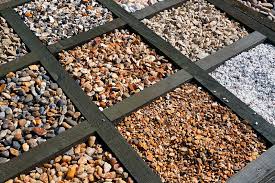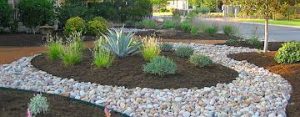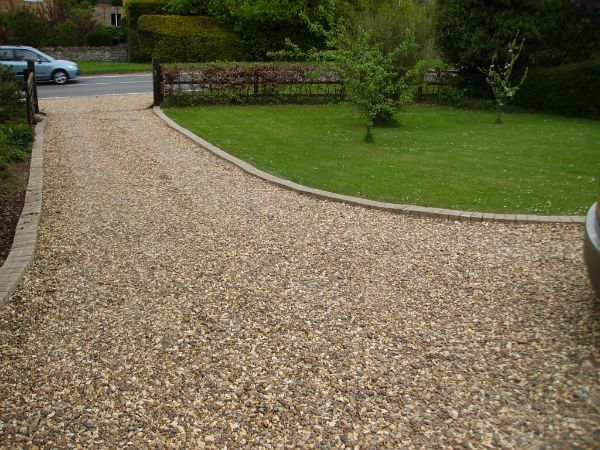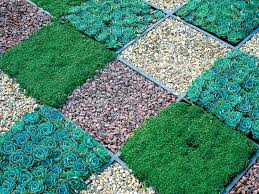
Not only does gravel have many shades, but it has many uses. It’s a budget-friendly and versatile paving material that will meet many of your landscaping, drainage or pathway needs. More often than not, the main decision isn’t what color of gravel to choose – it’s what size to use. That’s because not all gravel is created equal. The size that you would use for a walkway isn’t necessarily the best option for a rock garden. When you consider how much foot traffic the area will receive, then selecting the right size of gravel doesn’t have to be challenging.

1. Mulch substitute. Gravel is an effective mulch for plants because it helps prevent evaporation from the soil surface and, unlike wood mulch, isn’t prone to moving because of wind. Gravel that is 1/4 inch or smaller in diameter is moved more easily than larger gravel, so opt for medium-size gravel for flowerbeds and around trees.
An all-purpose gravel that is 3/8 inch in diameter works best for mulch around plants. Smooth gravel has a more decorative appearance than rough, angular gravel when used as mulch, but rough gravel may stay in place better.
Almost any size of gravel can be used in a rock garden because they don’t tend to have heavy foot traffic, and so the gravel merely serves as decoration. Large gravel is often the best choice because it stands well against boulders and other large rocks that may be in the rock garden. Try 1- to 1 ½-inch-diameter gravel as the top dressing in a rock garden. Smooth gravel made from river rock with rounded edges can give the area a more decorative appearance.

2. Drainage and Errosion Control. Use gravel in the bottom of flower pots to create a drainage foundation for flowers. In the absence of a gutter on the home, many people like to use a crushed stone drip edge to keep the storm water roof run-off from splashing dirt on their home siding.
Not to be confused with crushed base, crushed stone is a free-draining aggregate that is crushed down to three-quarter inch or 1 ½ inch. Crushed granite stone is processed from blasted granite ledge, so it is the most economical solution for drainage. Three-quarter inch is the most popular size used for drip edges along foundations or drainage behind retaining walls.
Shore up areas in the landscape at risk for soil erosion with gravel. Place beneath or around house drain pipes to prevent soil erosion in this location. Spread at the bottom of hills on your property as well as areas such as embankments.

3. Patio Base. The best gravel for using underneath a brick patio or concrete block retaining wall is often referred to as “processed gravel” “crushed base” or “bank run gravel.” This type of gravel has a mixture of fines that aid in compaction. It may look like sand with rocks in it. A crushed stone material like stone dust has too many fines. It’s not the “stone” in stone dust, but rather the “dust” that is a problem with frost. Fines hold water and expand when frost leaves the ground in spring time. Crushed base has fines in it, but any particles that are too fine had been removed with a sieve.

4. Walkways. Choosing the right gravel size for garden paths or walkways can make a significant difference in how comfortable they are to walk. The smaller or finer gravel is, the softer it is under foot, which is particularly important if you plan to walk on it in bare feet.
Opt for gravel that is 1/4 inch or smaller in diameter for the most comfortable walking surface. You’ll want to choose gravel that has a smooth texture, too, because rounded edges are less likely than sharp ones to hurt underfoot.

5. Driveways. Gravel can be used for driveway creation purposes regardless of size. It can be crushed and used in a concrete mixture, providing some traction to the drive. And it can be laid as is, regardless of size, onto a wide path of your property as a loose drive material. The many colors available in this drive paving substance (white, beige, brown, gray) provide ample variety choices when it comes to matching the drive with your home and landscaping colors.
A driveway requires a few layers of gravel to provide enough stability for vehicles. Start with a layer of stones that are about the size of baseballs or softballs, typically 3 to 4 inches in diameter. Next, install a layer of 2- to 3-inch-diameter stones. The driveway’s top dressing should consist of 3/8-inch-diameter gravel. Opt for crushed, man-made rock gravel because its pieces bind together well, increasing stability.

6. Landscaping Uses. Gravel can be used to make a flower garden border, used as filler on a path around large stepping stones, or as a pea or other gravel-sized walkway path between your home and your flower garden. With various sizes of gravel and colors available it can serve many uses in the landscape, including as a background for a rock garden containing boulders and other types and sizes of rocks.
Before you purchase gravel you will need to know how much you need for the area to be landscaped, and that means you need three dimensional measurements before you can do that. [See our Cubic Yards Calculator]

7. Accents. Gravel can be a good substitute for bark mulch. It absorbs the heat of the sun keeps the soil cool and moist throughout the summer, while weeds pull up fairly easily through gravel. One disadvantage of an aggregate-type of stone, however, is the sharp edges. River stone is the best choice for garden pathways in planting beds. Sifted down to an inch and a half, this naturally rounded stone is heavy enough to stay put, but is easy underfoot and gentle to the stems of plants. If you are putting in a Koi pond or similar type of water feature, river stone is the natural choice.
